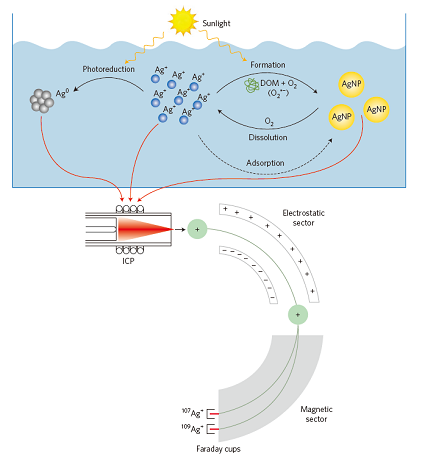| Location: Home>News>Events |
| Researchers Discover the Stable Isotope Fractionation in the Natural Transformation Process of Silver Nanoparticles |
|
|
The Qian Liu and Guibin Jiang group from the State Key Laboratory of Environmental Chemistry & Ecotoxicology, Research Center for Eco-Environmental Sciences of Chinese Academy of Sciences has recently achieved an important research progress on the stable isotope fractionation in the natural transformation process of silver nanoparticles. The paper has been published in Nature Nanotechnology (doi: 10.1038/nnano.2016.93). The researchers used natural stable isotopes to study the processes and sources of silver nanoparticles in the environment. They observed for the first time the stable isotope fractionation phenomena in the natural transformation processes of silver nanoparticles. They measured the subtle variations in silver isotope ratio caused by the natural transformation processes of silver nanoparticles by multi-collector inductively coupled plasma mass spectrometry (MC-ICP-MS), and found that different processes caused different isotope fractionation effects. The stable isotope fractionation can be used to reveal the transformation pathways and mechanisms of silver nanoparticles in natural waters. This natural stable isotope-based technique is totally different from the traditional concentration or particle size-based methods. This technique not only provides concentration-independent and multi-dimensional information for the studied processes, but also avoids the use of artificial or radioactive tracers. This work may also expand the application of stable isotopes to a new field. Furthermore, it should be noted that the researchers demonstrated the distinctly different isotope fractionation effects between engineered and naturally formed nanoparticles. This phenomenon reveals a potential approach to distinguish the sources of nanoparticles in the environment through the stable isotope fractionation effects. This work has been evaluated by the reviewers of Nature Nanotechnology as ‘a pioneering landmark study’, and this new technique is expected to be an ‘important tool in the future’. The same group has carried out systematic research works on environmental nanomaterials. In their previous works, they have established a capillary electrophoresis-inductively coupled plasma mass spectrometry (CE-ICP-MS) method for the characterization of nanoparticles in complex environmental media and commercial products. By using CE-ICP-MS, multi-dimensional information on chemical compositions, size distributions, and ionic species of multiple nanoparticles can be obtained in a single run (Angewandte Chemie International Edition, 2014, 53, 14476-14479; VIP paper). This study was supported by the National Nature Science Foundation of China, the Strategic Priority Research Program of CAS, the National Basic Research Program of China, and the Youth Innovation Promotion Association of CAS.
Scheme showing the stable isotope fractionation in the natural transformation processes of silver nanoparticles in natural waters State Key Laboratory of Environmental Chemistry and Ecotoxicology June 21, 2016 |
